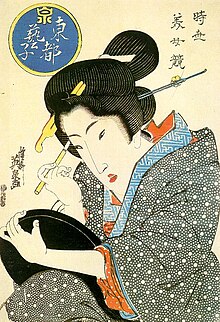Bijinga
Bijinga ( Japanese 美人 画 , dt. "Pictures of beautiful women") was the name of Ukiyo-e with depictions of women that corresponded to the contemporary ideal of beauty .
Before the Meiji period , the term Bijin-e ( 美人 絵 ) was used with the same meaning. bijin - actually "beautiful person" - experienced a narrowing of meaning to primarily women during the tenth and eleventh Tokugawa shogunate. Hence, bijin-e can also include representations of men. Bijinga is now a generic name for ukiyo-e used by beautiful women, regardless of when the artwork was created. The Kasei period (1804–1830) with its eponymous culture , when Torii Kiyonaga , Kitagawa Utamaro and Hosoda Eishi ( 細 田 栄 之 ; 1756–1829) created them, is considered the wedding of the Bijinga . In contrast to the yakusha-e ( 役 者 絵 ), ukiyo-e of Kabuki actors, which were created at the same time, the women depicted had no individual facial features.
Web links
- bijinga in the Japanese Architecture and Art Net Users System (English)
Individual evidence
- ↑ Mio Wakita: Selling Japan. Kusakabe Kimbei's Image of Japanese Women . In: History of Photography . May 2009, ISSN 0308-7298 , p. 209-223 , doi : 10.1080 / 03087290902768149 .
-
↑ bijinga in the Japanese Architecture and Art Net Users System
Note: Source writes "Kansei 寛 政 era (1804-1830)". However, this designates an era from 1789 to 1801. This refers however, the Kasei time ( 化政時代 ) derived from the eras Bunka ( 文化 ; 1804-1818) and Bunsei ( 文政 ; 1818-1830).
